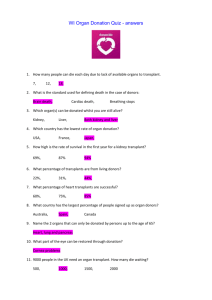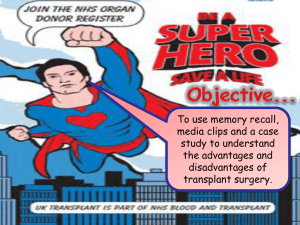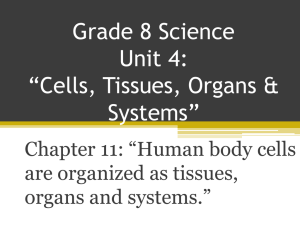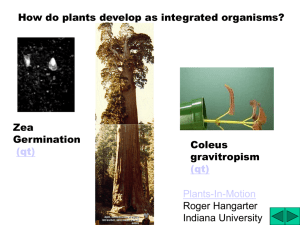DOWNLOAD and VIEW the full-length interview with Dr
advertisement
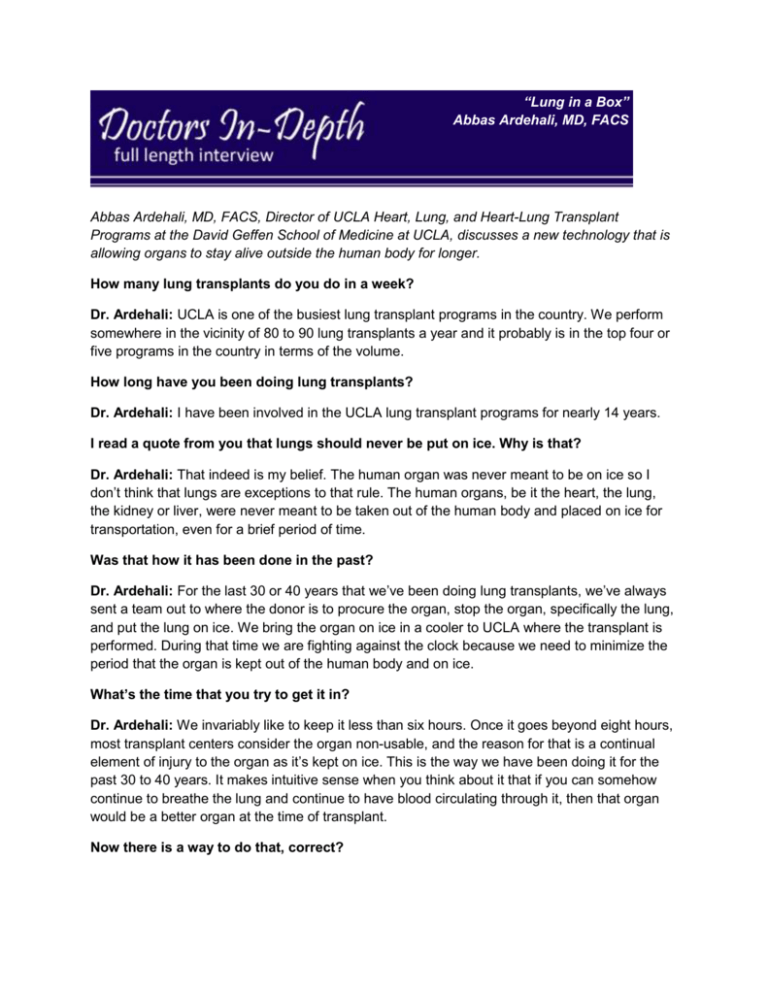
“Lung in a Box” Abbas Ardehali, MD, FACS Abbas Ardehali, MD, FACS, Director of UCLA Heart, Lung, and Heart-Lung Transplant Programs at the David Geffen School of Medicine at UCLA, discusses a new technology that is allowing organs to stay alive outside the human body for longer. How many lung transplants do you do in a week? Dr. Ardehali: UCLA is one of the busiest lung transplant programs in the country. We perform somewhere in the vicinity of 80 to 90 lung transplants a year and it probably is in the top four or five programs in the country in terms of the volume. How long have you been doing lung transplants? Dr. Ardehali: I have been involved in the UCLA lung transplant programs for nearly 14 years. I read a quote from you that lungs should never be put on ice. Why is that? Dr. Ardehali: That indeed is my belief. The human organ was never meant to be on ice so I don’t think that lungs are exceptions to that rule. The human organs, be it the heart, the lung, the kidney or liver, were never meant to be taken out of the human body and placed on ice for transportation, even for a brief period of time. Was that how it has been done in the past? Dr. Ardehali: For the last 30 or 40 years that we’ve been doing lung transplants, we’ve always sent a team out to where the donor is to procure the organ, stop the organ, specifically the lung, and put the lung on ice. We bring the organ on ice in a cooler to UCLA where the transplant is performed. During that time we are fighting against the clock because we need to minimize the period that the organ is kept out of the human body and on ice. What’s the time that you try to get it in? Dr. Ardehali: We invariably like to keep it less than six hours. Once it goes beyond eight hours, most transplant centers consider the organ non-usable, and the reason for that is a continual element of injury to the organ as it’s kept on ice. This is the way we have been doing it for the past 30 to 40 years. It makes intuitive sense when you think about it that if you can somehow continue to breathe the lung and continue to have blood circulating through it, then that organ would be a better organ at the time of transplant. Now there is a way to do that, correct? Dr. Ardehali: Now, there is a technology for the first time to keep a human organ alive outside of the human body for hours, and use that same organ, transplant it into another human being, and have that take over the body’s circulation and vital functions. Tell me, what is the organ care system? Dr. Ardehali: It is a platform to transport human organs while keeping a near physiologic state, meaning nearly alive. Then after a few hours we transplant those same organs and allow them the opportunity to resume the vital function of another human being. Now you have eight hours traditionally. Does this buy you more time? Dr. Ardehali: We believe it does. We believe that this has the potential to expand the duration to potentially up to 12 maybe 24 hours, but we do not know that at this point. We are in the stages of investigating this technology. This is a FDA trial which compares the old way of transporting organs mainly on ice with a new way, which is in a warm breathing near physiologic state. The study is a multi-center international study and we plan to enroll over 250 patients. Once the study is complete, we will see if this technology is superior to the current method of organ preservation. How will you know that? Dr. Ardehali: One of the parameters that we follow is how well the new lungs work after being implanted. We speculate that with the lungs being kept in a breathing warm perfused state, the organs that are transplanted are actually better organs. What happens to the lungs when it is kept on ice? Do they not perform as well? Dr. Ardehali: There is a finite injury to the organs on ice and that is why we have to fight against the clock during those six to eight hours to make sure the transplant is done during that period of time. We speculated that this technology decreases the severity of injury and preserves the organ in a better shape at the time of the transplantation. So, we believe that we may transplant better organs into patients. If the organ is better, what does that mean for the patient? What were the drawbacks before? Dr. Ardehali: If the organs are better, we believe that the patients will do better. They will be able to have fewer complications, stay in the hospital for a shorter period of time, and resume their normal lifestyles sooner. Can you tell me quickly how the box works? Dr. Ardehali: So, the box is a self-contained platform that has a pump, a tank of oxygen, and a lot of other machines and devices that circulate blood through the new lungs. There’s a tank that infuses oxygen into the lungs and we also have a way of treating potential infections in the donor lung; we can add antibiotics. We can also go to the airway of the new lungs and clear out secretions, mucus, or other sort of secretions that are there. So we have an opportunity to actually improve the quality of the organs that will ultimately be transplanted. Is there any downside to this? Dr. Ardehali: It’s interesting you mention that because when you talk to most people they say it makes intuitive sense and why didn’t you guys come up with this 20 years ago? The reality is a lot of people have put a lot of thought into this over the past several decades but the technology was not there to have a self-contained platform to maintain the organ in a near physiologic state. Now we are at a point in technology where this box is able to maintain that human organ in a near normal state. As far as that organ is concerned, it still feels like it’s in a human body because it’s still breathing, there’s still blood going through it, and as far as it knows it’s alive. That I think is a fascinating aspect of this technology, which is to maintain a human organ in a near live state for several hours outside of a human body and then transplant it into a recipient. In terms of downsides, we will be investigating the safety of this device as part of this ongoing study. It has been done with hearts already, right? Dr. Ardehali: It has been done in hearts and we are still completing the study. UCLA was amongst the leaders in the heart study and we expect that within the next couple months we will be completing the heart study. From a scientific standpoint I think the potential benefits of this technology are several fold. We touched on part of one of the areas that you mentioned, which is we believe this technology delivers a better organ for transplantation so ultimately the patients will do better. I think the real promise of this technology is that it can potentially expand the donor pool. There are about 75 to 80% of the lungs that we are not currently using because of a variety of factors such as pneumonia or damage to the lungs because of the state of brain death. We also have a lot of patients that are dying on the waiting list because there are not enough organs. A real promise of this technology is if it can allow us to improve the quality of the lungs that we are not currently using, to make them usable organs, it could potentially change the game. You actually will be expanding the donor pool, offering this life saving therapy to more patients, and potentially save many lives in the process. It is one thing to improve the quality of the organs that we’re currently using, but I think the greatest promise is expanding the donor pool and converting the organs that we are not currently using to usable organs. The patient we’re talking to is the only patient? Dr. Ardehali: No, we’ve done I think eleven or twelve patients. Do you know the name of the patient? Dr. Ardehali: Mr. Padilla. He’s your patient? Dr. Ardehali: Yes. How is he doing? Dr. Ardehali: He’s doing very well. He actually had a big operation and within a couple of weeks he was home and able to be back with his family for the holidays. He’s progressing very nicely from a lung standpoint. What was he like when you first saw him? Dr. Ardehali: He was quite limited. He had a condition called pulmonary fibrosis, which is a life threatening condition and as you may know, there are no formal therapies available for patients with end stage pulmonary fibrosis. Lung transplantation is the only option. He has had a significant change in his quality of life and we are optimistic that he will have a very healthy and prolonged life ahead of him. This information is intended for additional research purposes only. It is not to be used as a prescription or advice from Ivanhoe Broadcast News, Inc. or any medical professional interviewed. Ivanhoe Broadcast News, Inc. assumes no responsibility for the depth or accuracy of physician statements. Procedures or medicines apply to different people and medical factors; always consult your physician on medical matters. If you would like more information, please contact: Amy Albin Sr. Media Relations Representative UCLA Health Sciences Media Relations (310) 794-0777 aalbin@mednet.ucla.edu Sign up for a free weekly e-mail on Medical Breakthroughs called First to Know by clicking here.



